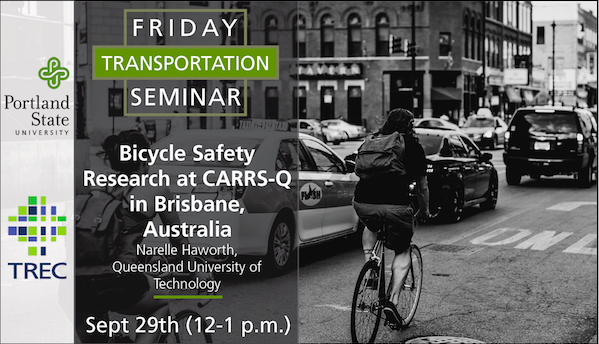The video begins at 2:13.
View slides
Abstract: City of Davis Bicycle and Pedestrian Coordinator Tara Goddard recently visited Sangju, South Korea as part of a "sister city" delegation. Sangju is the "Bike City" of Korea, with a bicycle mode share approximately that of Davis and Portland combined. Tara will share photos and lessons learned from that trip, compare the bicycle facilities of Sangju with that of Davis and Portland, and discuss opportunities for future bicycle research in East Asia.
Friday Transportation Seminar: Bicycle Safety (and Other) Research at CARRS-Q in Brisbane, Australia
LOCATION: PSU, Urban Center Building, Room 204 (Distance Learning Center Wing)
LIVESTREAM ONLINE: Click here on the day of the seminar to stream it live
SEMINAR VIDEO
This presentation will begin with an overview of the activities of the Centre for Accident Research and Road Safety-Queensland. Then a number of bicycle safety research projects...
Read moreThe video begins at 0:29.
View slides
Speaker: Brian Saelens, Professor of Pediatrics and Psychiatry & Behavioral Sciences, Seattle’s Children’s Hospital & University of Washington
Topic: Links Between Public Transportation and Physical Activity (Effects of LRT on Physical Activity Based on Seattle GPS Study)
Summary: This seminar will explore the empirical evidence regarding the links between the use of public transportation and physical activity, with a specific focus on using integrated device and self-report methods to identify travel modes and physical activity.
Bio: Brian E. Saelens, Ph.D. is a Professor of Pediatrics and Psychiatry & Behavioral Sciences at the University of Washington and Principal Investigator at Seattle Children’s Research Institute. Dr. Saelens is a clinical/health psychologist. His interest areas include obesity treatment and prevention, especially in environmental factors and policies that influence physical activity and eating behaviors in children and adults. He has published over 150 peer-reviewed original investigation and review articles.
View slides
If you would like to receive continuing education credits such as PDH or CM, please make sure to complete this evaluation form once you've watched the entire video so that we have a record of your attendance.
Watch video.
Oregon, and Portland in particular, is internationally known for its love for bikes. Not only does the region have some of the highest bike ridership in the nation but the Oregon bike manufacturing industry is quickly growing as well. Oregon’s electric bike (e-bike) market is also growing, but little data are available on the potential market and e-bike user behavior and interest.
Only a limited amount of research has explored the potential new market segments for e-bikes and the economic, operational, safety, and transportation issues surrounding e-bikes in the United States. This webinar will present findings from a research project evaluating e-bike use at three Kaiser Permanente employment centers in the Portland region.
The project's primary goal was to test user...
Read moreThe video begins at 2:34.
View slides
Other presentation materials: Handout (PDF)
Summary: The recent City Club report on bicycling provided an opportunity to collect and analyze a number of data sets including the new Hawthorne Bridge data. One question is where Portland bicycling on the logistic curve -- a common tool for judging the maturity of a developing product or activity. Logistic curves are used for marketing, for epidemiology, and even for visits to Indian owned casinos. The preliminary evidence is that we are reaching the horizontal area of the curve. Additional evidence Our further research into future policies indicates a shift to bicycle boulevards in order to attract more risk averse riders.
Bio: Robert McCullough is an energy economist (and an adjunct at PSU) who has written, talked, and testified on energy issues across the U.S. and Canada. He was instrumental in the identification and prosecution of Enron's energy traders. He also works with aboriginal groups in Quebec and Oregon, activists in California and Ohio, as well as many others. His most recent project is the economic review of the WNP-2 nuclear station for Physicians for Social...
Read morePRESENTATION SLIDES
Want a look back at the presentation slides? View them here.
Emerging probe data sources from smartphones on on-board devices are able to measure behavior of cyclists with very high...
Read more

